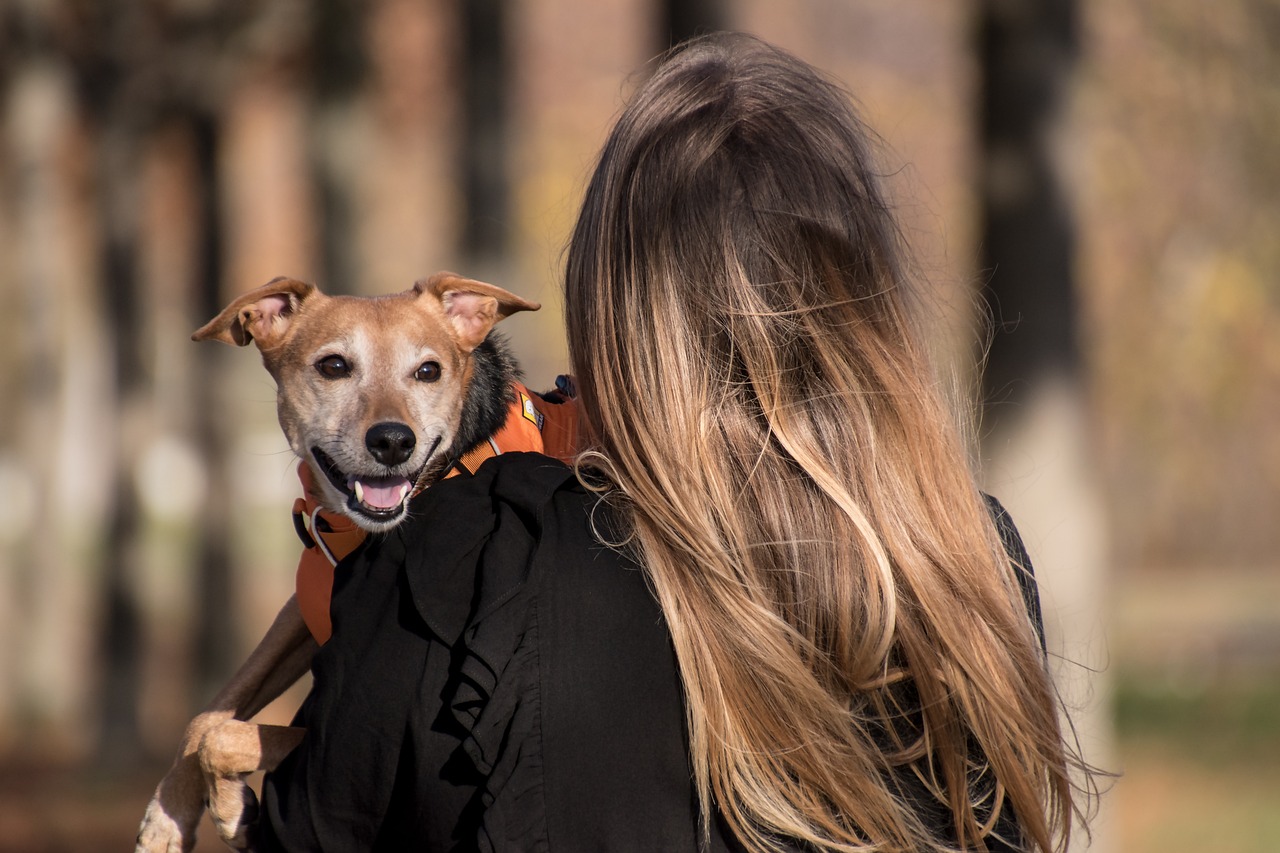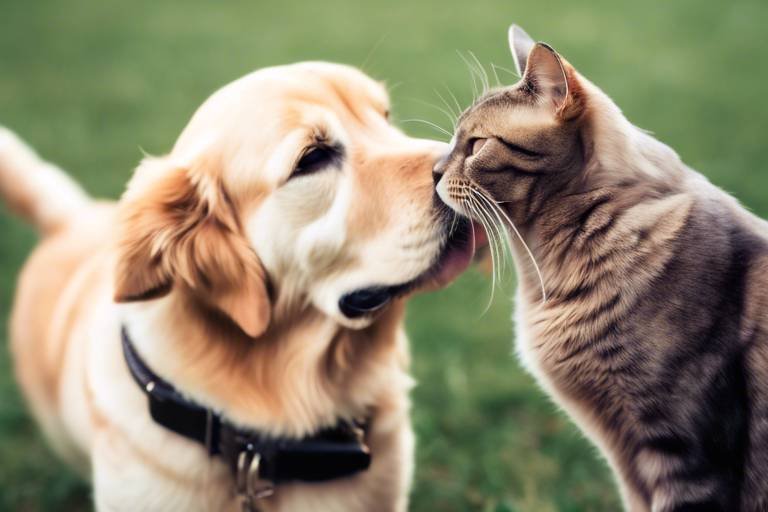How to Help Your Pet with Social Anxiety
Social anxiety isn't just a human problem; our furry friends can experience it too! If you've noticed your pet acting nervous, avoiding social situations, or showing signs of distress around other animals or people, you're not alone. Many pet owners face the challenge of helping their beloved companions feel more at ease in various social settings. In this article, we will explore effective strategies and tips to assist pets suffering from social anxiety, ensuring they feel more comfortable and secure. Think of this as a roadmap to guide your pet through the sometimes overwhelming world of social interactions.
Before we dive into solutions, it’s essential to recognize the signs of social anxiety in pets. Understanding what your pet is going through can make all the difference in their comfort level. Common behaviors that indicate anxiety include excessive barking, hiding, or even destructive behavior when faced with unfamiliar situations. By being observant, you can spot these signs early and take action. Remember, just like humans, pets experience a range of emotions. They might not be able to tell you they’re feeling anxious, but their behavior often speaks volumes.
Every pet is unique, and so are their triggers for anxiety. Understanding what sets off your pet’s anxiety is crucial for effective management. Triggers can vary widely from loud noises, such as thunderstorms or fireworks, to unfamiliar people or pets invading their space. It’s like trying to solve a puzzle; once you identify the pieces, you can create a clearer picture of how to help your pet. Keep a journal of your pet’s behavior in different situations to identify patterns and specific triggers that provoke their anxiety.
Several situations can trigger anxiety in pets, and being aware of these can help you prepare and mitigate their impact. Here are some common triggers to watch out for:
- Loud Noises: Fireworks, thunder, or even vacuum cleaners can send some pets into a tailspin.
- Unfamiliar People: Strangers entering your home or new visitors can make your pet feel uneasy.
- Other Animals: Encounters with other pets, especially in confined spaces, can be overwhelming.
- Changes in Routine: A sudden change in your daily schedule can unsettle your pet.
The environment plays a significant role in a pet's anxiety levels. Changes in surroundings, such as moving to a new home or rearranging furniture, can leave pets feeling disoriented. Imagine how you would feel if your favorite chair suddenly disappeared! It's crucial to maintain a consistent environment for your pet whenever possible. If changes are unavoidable, try to introduce them gradually, allowing your pet to adjust at their own pace.
Social interactions can be particularly overwhelming for anxious pets. The presence of too many people or other animals can create a chaotic atmosphere that heightens their anxiety. Always observe your pet's body language during these interactions; signs such as cowering, growling, or attempting to escape indicate they are uncomfortable. By recognizing these cues, you can intervene and help your pet navigate these situations more smoothly.
Recognizing behavioral signs of anxiety in pets is crucial for timely intervention. Here are some physical and emotional signs to watch for:
- Excessive Barking or Whining: This can indicate distress.
- Hiding or Withdrawal: If your pet seeks solitude, it may be a sign they are feeling overwhelmed.
- Destructive Behavior: Chewing or scratching furniture can be a coping mechanism for anxiety.
- Changes in Eating Habits: A loss of appetite or overeating can also signal anxiety.
Establishing a safe and comfortable environment can significantly reduce anxiety in pets. Think of this space as a sanctuary where your pet can retreat when feeling overwhelmed. This area should be quiet, cozy, and filled with familiar items, such as their favorite blanket or toys. By giving your pet a designated safe space, you empower them to manage their anxiety more effectively.
A comfort zone is vital for anxious pets. Choose a location in your home that is away from the hustle and bustle. It could be a quiet corner of a room or a cozy crate. Make it inviting with soft bedding and toys that your pet loves. The goal is to create a space where your pet feels secure and can relax when the world feels too overwhelming.
Calming aids can help alleviate anxiety in pets. Consider using products like pheromone diffusers, which release calming scents, or soothing music designed specifically for pets. These aids can create a more tranquil environment, helping your pet to unwind and feel at ease. Just like humans benefit from a calming playlist, pets can also enjoy the soothing effects of gentle sounds.
Gradual exposure can help your pet become accustomed to social situations. This technique involves slowly introducing your pet to their triggers in a controlled manner. Start with less intimidating situations and gradually work your way up to more challenging scenarios. This process is akin to dipping your toes into a pool before diving in; it allows your pet to acclimatize to their fears at a comfortable pace.
Desensitization involves slowly introducing your pet to their triggers. Begin with short, controlled encounters and gradually increase exposure time as your pet becomes more comfortable. For example, if your pet is anxious around strangers, invite a calm friend over for a brief visit while keeping your pet at a distance. Over time, as your pet learns that these encounters are safe, their anxiety should decrease.
Using positive reinforcement can encourage desired behaviors in anxious pets. Reward your pet with treats or praise when they exhibit calm behavior during social interactions. This technique builds their confidence and helps them associate positive experiences with previously anxiety-inducing situations. Think of it as giving your pet a high-five for being brave!
Sometimes, professional help is necessary for pets with severe anxiety. If your pet's anxiety is significantly impacting their quality of life, it may be time to consult a veterinarian or animal behaviorist. These professionals can provide tailored advice and support to help your pet cope more effectively.
Behavioral therapy can be an effective solution for anxious pets. Professionals may recommend various therapeutic approaches, including cognitive-behavioral therapy (CBT) and desensitization techniques. These methods focus on changing your pet's response to anxiety-inducing situations, helping them develop coping strategies.
In some cases, medication may be required to manage anxiety. If your pet's anxiety is severe, your veterinarian may prescribe anti-anxiety medications to help them feel more relaxed. It's essential to discuss the potential benefits and side effects with your vet to make an informed decision. Remember, medication is often most effective when combined with behavioral therapies.
1. How can I tell if my pet has social anxiety?
Look for signs such as excessive barking, hiding, destructive behavior, or changes in eating habits. If your pet seems uncomfortable in social situations, they may be experiencing anxiety.
2. What should I do if my pet shows signs of anxiety?
Create a safe space for your pet, identify triggers, and consider gradual exposure techniques. If anxiety persists, consult a veterinarian for professional advice.
3. Are there specific calming aids that work best for pets?
Pheromone diffusers, calming music, and anxiety wraps are popular options. However, every pet is different, so it may take some experimentation to find what works best for your furry friend.
4. When should I seek professional help for my pet's anxiety?
If your pet's anxiety significantly affects their quality of life or if home remedies aren't helping, it’s time to consult a veterinarian or animal behaviorist.

Understanding Social Anxiety in Pets
Just like humans, pets can experience social anxiety, which can manifest in various ways. Imagine walking into a crowded room and feeling overwhelmed by the noise and the number of people around you; that’s how your furry friend might feel in social settings. It's essential to recognize the signs of social anxiety in your pets to provide them with the support they need. Common behaviors include excessive barking, hiding, or even destructive actions when faced with unfamiliar situations.
Often, pets may display physical signs such as trembling, avoiding eye contact, or keeping their tails tucked. These behaviors indicate that they are not comfortable in their current environment. It's crucial to pay attention to these signs and understand that your pet's anxiety is not just a phase; it’s a real issue that requires your attention. You might notice that your pet becomes anxious around certain people or in specific situations, which can help you identify their triggers.
To help you better understand social anxiety in pets, here are some common symptoms to look out for:
- Excessive Barking: This can be a sign of distress or an attempt to communicate their discomfort.
- Destructive Behavior: Chewing furniture or scratching at doors can indicate that your pet is trying to escape their anxiety.
- Avoidance: Hiding or trying to escape when guests arrive is a clear indication of anxiety.
- Pacing: Restlessness and inability to settle down can also signify anxiety.
Understanding these signs is the first step towards helping your pet feel more secure. Just like we might seek comfort in a familiar place when feeling anxious, pets also benefit from knowing they have a safe space to retreat to when they feel overwhelmed. By recognizing and addressing these behaviors early on, you can prevent the anxiety from escalating and help your pet develop more confidence in social situations.
In summary, social anxiety in pets is a significant issue that can affect their quality of life. By being observant and proactive, you can create an environment that supports your pet's emotional well-being. Remember, your pet relies on you to help them navigate their fears and anxieties, so take the time to understand what they are going through.
Q: Can social anxiety in pets be treated?
A: Yes, social anxiety in pets can be managed through various techniques, including gradual exposure, creating a safe space, and using calming aids.
Q: How can I tell if my pet is anxious?
A: Look for signs such as excessive barking, hiding, pacing, or destructive behavior. Each pet may exhibit different signs, so it's essential to know your pet's normal behavior.
Q: Should I consult a veterinarian for my pet's anxiety?
A: If your pet's anxiety is severe or persistent, it's a good idea to consult a veterinarian or an animal behaviorist for professional guidance and support.

Identifying Triggers
Understanding what triggers your pet's anxiety is crucial for effective management. Just like humans, pets can have their own unique set of stressors that make them feel uneasy or scared. Identifying these triggers is the first step toward helping your furry friend feel more secure and comfortable in their environment. Think of it as a detective story where you, as the pet owner, are the investigator trying to uncover the mysteries behind your pet's anxious behavior.
Common triggers can vary widely among different pets, but they often include environmental factors, social interactions, and even specific sounds. For instance, some dogs may become anxious during thunderstorms, while others might feel overwhelmed in crowded places. Cats, on the other hand, might be spooked by the presence of unfamiliar animals or loud noises. By closely observing your pet’s reactions, you can begin to piece together what situations cause them distress.
Here are some of the most frequent triggers that you should be aware of:
- Loud Noises: Thunder, fireworks, and even the sound of a vacuum cleaner can send your pet into a panic.
- Strange People or Animals: New faces or unfamiliar pets can create a sense of danger in your pet's mind.
- Changes in Routine: Pets thrive on routine, and any disruption can lead to anxiety.
- Traveling: Car rides or trips to the vet can be particularly stressful for some pets.
Environmental factors also play a significant role in your pet's anxiety levels. For example, moving to a new home can be overwhelming for your pet as they adjust to unfamiliar sights, sounds, and smells. Similarly, a change in family dynamics—like a new baby or pet—can trigger feelings of insecurity. It’s essential to recognize that these changes, no matter how small they may seem to you, can have a profound effect on your pet.
Social interactions can be another major source of anxiety. For instance, your pet might feel stressed during playdates with other animals or even when meeting new people. Some pets are naturally more sociable than others, and pushing an anxious pet into social situations without proper preparation can lead to increased fear and anxiety. Observe how your pet behaves in various social settings and take note of their comfort levels. This will help you understand their boundaries and provide the support they need.
In summary, identifying triggers is an essential step in addressing your pet's social anxiety. By paying close attention to their behaviors and reactions, you can create a more comfortable and supportive environment for them. Remember, just like a puzzle, every piece matters, and understanding these triggers will help you put together a clearer picture of your pet's emotional well-being.
Common Triggers
Understanding the common triggers of social anxiety in pets is crucial for any pet owner who wants to ensure their furry friends feel safe and secure. Just like humans, pets can become anxious due to various situations and stimuli in their environment. Identifying these triggers is the first step in helping your pet cope with their anxiety. You might be surprised to learn that even minor changes in their surroundings can have a significant impact on their emotional well-being.
Some of the most common triggers include:
- Loud Noises: Thunderstorms, fireworks, and even the sound of a vacuum cleaner can send your pet into a tailspin of anxiety. These sudden loud noises often catch pets off guard, causing them to feel threatened and insecure.
- Unfamiliar People: New faces can be intimidating for your pet, especially if they haven't been socialized properly. The presence of strangers can create a sense of unease, prompting your pet to retreat or react defensively.
- Other Animals: Encounters with other pets, especially if they are larger or more aggressive, can trigger anxiety. Your pet may feel threatened or overwhelmed, leading to anxious behavior.
- Changes in Routine: Pets thrive on routine. Any disruption, such as a change in feeding times, moving to a new home, or changes in family dynamics, can cause stress and anxiety.
- Travel: Whether it's a trip to the vet or a long car ride, travel can be a significant source of anxiety for pets. The unfamiliar environment and motion can be disorienting and frightening for them.
It’s essential to observe your pet's behavior closely during these triggering situations. Look for signs of anxiety, such as excessive barking, hiding, or even destructive behavior. By recognizing these triggers, you can work towards minimizing their impact on your pet’s life. For instance, if loud noises are a problem, consider creating a safe haven where your pet can retreat when they feel overwhelmed. Just like a child might seek comfort in a favorite blanket during a storm, your pet will benefit from having a designated space that feels secure.
Moreover, it’s important to remember that every pet is unique. What may trigger anxiety in one animal may not affect another in the same way. Therefore, taking the time to understand your pet's individual needs and responses is key to helping them navigate their world with confidence.
In summary, recognizing and addressing common triggers of social anxiety in pets is a vital part of their care. By being proactive and observant, you can create a more comfortable and supportive environment for your furry companion.
Q: How can I tell if my pet is anxious?
A: Look for signs such as excessive barking, hiding, shaking, or destructive behavior. If your pet seems unusually restless or avoids social interactions, they may be experiencing anxiety.
Q: Are certain breeds more prone to anxiety?
A: Yes, some breeds are more sensitive and prone to anxiety. Breeds like Chihuahuas, Border Collies, and German Shepherds may be more susceptible to anxiety due to their temperament.
Q: Is it normal for pets to have anxiety?
A: Yes, just like humans, pets can experience anxiety. It’s important to address it to ensure their well-being.
Q: Can I train my pet to overcome anxiety?
A: Absolutely! With techniques like gradual exposure and positive reinforcement, you can help your pet build confidence and reduce anxiety over time.
Environmental Factors
When it comes to your pet's anxiety, the environment they inhabit plays a crucial role. Just like humans, pets can be significantly affected by their surroundings, and understanding this can help you create a more comfortable space for them. Imagine living in a house that's constantly noisy or filled with unfamiliar scents; it would be overwhelming, right? Similarly, your furry friend may feel stressed and anxious in such situations.
There are several environmental factors that can contribute to your pet's anxiety levels. For instance, changes in the household—like moving to a new home, the arrival of a new family member, or even rearranging furniture—can unsettle your pet. Pets thrive on routine and familiarity, so any disruption can lead to feelings of insecurity. Additionally, factors like loud noises from nearby construction, thunderstorms, or even the sound of fireworks can trigger anxiety. These loud sounds can be startling and frightening for pets, causing them to feel vulnerable.
Another key aspect to consider is the presence of other animals. If your pet is not socialized well, the sight or sound of other pets can provoke anxiety. For example, if you have a dog that has had a negative experience with another dog, the mere presence of another canine can send them into a panic. It's essential to monitor how your pet reacts to other animals in their environment and take steps to mitigate any anxiety-inducing situations.
To illustrate how environmental factors can impact your pet, consider the following table:
| Environmental Factor | Potential Impact on Pet |
|---|---|
| Loud Noises | Can cause fear and panic, leading to destructive behavior. |
| Changes in Routine | May result in confusion and insecurity, increasing anxiety. |
| Presence of Other Animals | Can trigger fear or aggression, especially if past experiences were negative. |
| New Environments | Can overwhelm pets, making them feel lost and anxious. |
Creating a stable environment is vital for your pet's mental health. Try to maintain a consistent routine, minimize loud disturbances, and provide a safe space where your pet can retreat when feeling overwhelmed. By paying close attention to these environmental factors, you can significantly reduce your pet's anxiety levels, helping them feel more secure and comfortable in their home.
Social Interactions
Social interactions can be a minefield for pets suffering from anxiety. Just like humans, our furry friends can feel overwhelmed when faced with unfamiliar situations or new faces. Imagine walking into a crowded room where everyone is staring at you; that’s how your pet might feel when encountering strangers or other animals. The key to helping them navigate these interactions lies in understanding their feelings and providing the right support.
When it comes to social interactions, it's essential to identify the different types that can trigger anxiety in your pet. For instance, encounters with other pets can be daunting, particularly if your pet has had negative experiences in the past. Similarly, meeting new people—especially those who may approach too quickly or make loud noises—can send your pet into a tailspin of fear. Each interaction can vary in intensity, and recognizing these nuances can help you prepare your pet better.
One effective way to ease your pet into social situations is to gradually expose them to these environments. Start with low-pressure settings, such as inviting a calm friend over to your home. This familiar territory can help your pet feel more at ease. Over time, you can increase the complexity of the interactions, such as visiting a dog park during off-peak hours or attending a pet-friendly event where the crowd is manageable. By taking baby steps, you can help your pet build confidence without overwhelming them.
It’s also important to monitor your pet’s body language during these interactions. Look for signs of discomfort, such as:
- Tail tucked between legs
- Excessive panting
- Whining or barking
- Attempting to hide or escape
Understanding these signals will allow you to intervene before anxiety escalates. If you notice your pet becoming stressed, it’s perfectly okay to remove them from the situation and give them a break. Remember, the goal is to create positive associations with social interactions, not to force them into discomfort.
Finally, consider the role of your own behavior during these interactions. Pets are incredibly perceptive and can pick up on their owner's emotions. If you’re anxious or stressed about a social situation, your pet will likely mirror those feelings. Stay calm and relaxed, and use a soothing voice to reassure your pet. This can make a world of difference in how they perceive and react to social situations.
Signs of Anxiety
Recognizing the signs of anxiety in your pet is crucial for timely intervention. Just like humans, pets can experience a range of emotions, and anxiety is one of the most common issues they face. It's essential to be vigilant and attentive to your furry friend's behavior as it can provide valuable insights into their emotional state. You might notice your pet acting differently in various situations, which could be a clear indicator of anxiety.
Some common signs of anxiety include excessive barking or whining, destructive behavior, and withdrawal from social interactions. For instance, if your dog suddenly starts barking at every little noise or if your cat hides under the bed when guests arrive, these could be signs that they are feeling anxious. Additionally, physical symptoms such as trembling, pacing, or even changes in appetite can manifest when a pet is feeling stressed.
Here’s a quick breakdown of some key signs to watch for:
- Excessive Vocalization: Barking, whining, or meowing more than usual can indicate distress.
- Destructive Behavior: Chewing on furniture or scratching at doors when left alone can be a cry for help.
- Withdrawal: Hiding or avoiding interaction with family members or other pets may signal anxiety.
- Physical Symptoms: Trembling, pacing, or excessive grooming can also be signs of anxiety.
- Changes in Appetite: Eating less or more than usual can indicate emotional distress.
It's important to remember that each pet is unique, and their signs of anxiety may vary. Some pets may show overt signs of distress, while others may exhibit more subtle changes in behavior. Pay close attention to any shifts in your pet's demeanor, as these can be critical in understanding their emotional well-being. By being proactive and observant, you can help your pet feel more secure and comfortable in their environment.
In conclusion, recognizing the signs of anxiety in pets is the first step toward helping them overcome their fears. By understanding their behavior and being attentive to their needs, you can create a more supportive and nurturing environment for your beloved companion.
Q1: How can I tell if my pet is anxious?
A1: Look for signs such as excessive vocalization, destructive behavior, withdrawal, physical symptoms like trembling or pacing, and changes in appetite. Each pet may exhibit different signs, so it’s essential to observe their behavior closely.
Q2: What should I do if I notice signs of anxiety in my pet?
A2: If you notice signs of anxiety, consider creating a safe space for your pet, using calming aids, and gradually exposing them to their triggers. If the anxiety persists, consult a veterinarian or an animal behaviorist for professional guidance.
Q3: Can anxiety in pets be treated?
A3: Yes, anxiety in pets can be treated through behavioral therapy, gradual exposure techniques, and, in some cases, medication. It’s important to consult with a professional to determine the best course of action for your pet.

Creating a Safe Space
Creating a safe space for your pet is not just a luxury—it's a necessity. Just like humans, pets need a sanctuary where they can retreat when the world feels overwhelming. Imagine coming home after a long day, and instead of the usual chaos, there’s a cozy corner just for you, filled with your favorite things. That's what a safe space should feel like for your furry friend. It’s about establishing a comfortable zone where they can relax, feel secure, and recharge their emotional batteries.
To start, you’ll want to choose a location that is quiet and away from the hustle and bustle of daily life. This could be a corner of a room, a separate room altogether, or even a cozy nook under the stairs. The key is to find a spot where your pet can feel hidden yet safe. Once you've selected the location, it’s time to make it inviting. Here are some elements to consider:
- Comfortable Bedding: Invest in a soft, plush bed that your pet can curl up in. Think of it as their personal cloud where they can drift off into a peaceful slumber.
- Favorite Toys: Include a few of their favorite toys or blankets to provide a sense of familiarity. These items can serve as comforting reminders of home.
- Calming Scents: Consider using calming sprays or diffusers that contain pheromones, which can help soothe anxious pets. Just like how a familiar scent can bring back memories for us, it can do the same for them.
- Low Light: If possible, keep the area dimly lit to create a relaxing atmosphere. Bright lights can be harsh and overwhelming, especially for an anxious pet.
Once the space is set up, it’s important to encourage your pet to use it. You can do this by leading them there during stressful situations or even during regular quiet times. Use treats or their favorite toys to entice them into their safe space. Over time, they will associate this area with comfort and security, making it their go-to spot when anxiety strikes.
Additionally, you should be mindful of the noise levels in your home. If your pet is particularly sensitive to sounds, try to minimize loud noises in or around their safe space. You might even consider using white noise machines or calming music to mask any sudden or jarring sounds. Remember, it’s all about creating an environment that feels as safe and soothing as a warm hug.
Lastly, don’t forget that patience is key. It might take some time for your pet to fully embrace their new safe space. Just like us, they need to feel comfortable before they can truly relax. So, keep the door open for them and let them explore their sanctuary at their own pace. With time, your pet will learn to seek out this special place whenever they need a break from the world.
Q: How do I know if my pet is using their safe space?
A: You may notice your pet spending more time in that area, especially during stressful moments. Look for signs of relaxation, like lying down or playing with their toys in that space.
Q: Can I use the safe space for training purposes?
A: Yes! You can gradually introduce training sessions in their safe space, as it can help them feel more at ease and focused.
Q: What if my pet refuses to go to their safe space?
A: Be patient and try to make the space more appealing. Use treats or toys to encourage them and ensure the environment remains calm and inviting.
Designating a Comfort Zone
Creating a designated comfort zone for your pet is a crucial step in helping them cope with social anxiety. Just like we all have our favorite spots in our homes where we feel safe and relaxed, pets also need their own special place to retreat to when the world feels overwhelming. This comfort zone should be a sanctuary where your pet can unwind, free from the chaos of everyday life. To start, choose a quiet area in your home, away from the hustle and bustle, where your pet can feel secure.
When setting up this space, consider incorporating familiar items that your pet loves. This could be their favorite blanket, a few toys, or even a piece of your clothing that carries your scent. These items can provide a sense of familiarity and comfort. Think of it as creating a cozy den—something that invites your pet to snuggle up and relax. You could also add a soft bed or a crate, depending on what your pet prefers, to make the space even more inviting.
It's important to make this comfort zone accessible at all times. If your pet feels anxious, they should know they have a safe place to escape to. You might want to leave the door to this area open or create a clear pathway that leads to it. Additionally, consider using calming aids like pheromone diffusers or soft music to enhance the soothing atmosphere of the space. Remember, this comfort zone isn’t just a physical space; it’s a mental refuge where your pet can feel at ease.
Lastly, be patient. It may take some time for your pet to recognize this comfort zone as their safe haven. Encourage them to explore it by using treats or toys, and always respect their need for space. Over time, they will associate this area with safety and relaxation, helping to alleviate their anxiety when faced with stressful situations.
- How can I tell if my pet is using their comfort zone? Look for signs like your pet spending time in the area, lying down, or playing with their toys. If they seem relaxed and content, they are likely finding comfort there.
- What should I do if my pet refuses to enter their comfort zone? Encourage them gently with treats or toys. You can also sit in the space with them initially to create a sense of safety.
- Can I change the location of the comfort zone later? Yes, but do so gradually. If you need to relocate it, ensure the new area is still quiet and safe, and help your pet adjust by introducing them slowly.
- Are there specific items I should include in the comfort zone? Yes, items like their favorite blanket, toys, and anything that smells like you can help make the space more inviting.
Using Calming Aids
When it comes to helping our furry friends cope with social anxiety, calming aids can be a game changer. These aids are designed to create a peaceful environment, making it easier for pets to relax and feel secure. You might wonder, "What exactly are calming aids?" Well, they can range from natural remedies to technological solutions. The key is to find what works best for your pet, as each animal is unique in their responses.
One popular type of calming aid is pheromone diffusers. These devices release synthetic versions of the calming pheromones that mother dogs and cats produce to comfort their young. By mimicking these natural scents, pheromone diffusers can create a soothing atmosphere in your home. They’re particularly effective when used in high-anxiety situations, such as during thunderstorms or fireworks. Just plug it in and let the magic happen!
Another option is calming music. Yes, you read that right! Studies have shown that certain types of music can help reduce anxiety in pets. There are even playlists specifically designed for pets that incorporate soothing sounds and gentle melodies. Playing this type of music during stressful situations can help your pet feel more at ease. Imagine your pet lounging comfortably while you play some soft tunes in the background—sounds relaxing, right?
In addition to these methods, there are also natural supplements available that can help calm your pet. Ingredients like valerian root, chamomile, and L-theanine are often found in these products. However, it’s crucial to consult with your veterinarian before introducing any new supplements to your pet’s routine. You want to ensure they’re safe and appropriate for your specific pet’s needs.
Lastly, consider the use of anxiety wraps. These snug-fitting garments apply gentle pressure to your pet’s body, similar to a hug. This pressure can have a calming effect, helping to reduce feelings of anxiety. Many pet owners report positive results after trying anxiety wraps, especially during stressful events.
In summary, calming aids can significantly improve your pet’s ability to handle social anxiety. Whether you choose pheromone diffusers, calming music, natural supplements, or anxiety wraps, the goal is to create a supportive environment where your pet can thrive. Remember, it's all about trial and error to find the right combination that works for your furry friend!
- What are calming aids? Calming aids are products designed to help alleviate anxiety in pets, including pheromone diffusers, calming music, natural supplements, and anxiety wraps.
- Are calming aids safe for my pet? Most calming aids are safe, but it's always best to consult with your veterinarian before introducing any new product.
- How long does it take for calming aids to work? The effectiveness of calming aids can vary. Some may provide immediate relief, while others might take time to show results.
- Can I use calming aids along with other anxiety treatments? Yes, many calming aids can be used in conjunction with behavioral therapy or medication, but always check with your vet first.

Gradual Exposure Techniques
When it comes to helping your pet overcome social anxiety, can be a game-changer. Think of it like teaching a child to swim; you wouldn’t throw them into the deep end right away, would you? Instead, you’d start in the shallow end, allowing them to get comfortable with the water. Similarly, by slowly introducing your pet to social situations, you can help them build confidence and reduce their anxiety over time.
To successfully implement gradual exposure, begin by identifying the specific situations that trigger your pet’s anxiety. This could range from encounters with other dogs to the presence of strangers in your home. Once you’ve pinpointed these triggers, you can start the exposure process in a controlled and safe environment. For example, if your dog is anxious around other dogs, consider arranging low-key meetups with calm, friendly dogs. This allows your pet to experience social interactions without feeling overwhelmed.
Here’s a simple step-by-step guide to help you through the desensitization process:
- Start Small: Begin with situations that are slightly less intimidating for your pet. If they’re fearful of loud noises, start with soft sounds and gradually increase the volume.
- Short Sessions: Keep exposure sessions short and positive. Gradually increase the duration as your pet becomes more comfortable.
- Monitor Body Language: Always watch for signs of stress or anxiety in your pet. If they seem overwhelmed, take a step back and allow them to regroup before trying again.
- Use Positive Reinforcement: Reward your pet with treats or praise when they display calm behavior during exposure. This reinforces their confidence and encourages them to face their fears.
As you progress, you might find that your pet begins to show signs of excitement rather than fear in previously anxiety-inducing situations. This is a clear indication that your gradual exposure techniques are working! Remember, patience is key. It may take time for your pet to fully adjust, but with persistence and love, you can help them navigate their social world more comfortably.
In addition to gradual exposure, consider combining these techniques with calming aids. Products like pheromone diffusers or calming music can create a soothing environment that supports your pet during the desensitization process. The goal is to create a positive association with social situations, making them feel safe and secure.
Ultimately, every pet is unique, and their journey to overcoming social anxiety will differ. By adopting gradual exposure techniques, you’re not just helping them face their fears; you’re also strengthening the bond between you and your furry friend. So, gear up for this rewarding adventure, and watch as your pet transforms into a more confident companion!
- How long does it take for my pet to overcome social anxiety? Each pet is different; some may take weeks, while others might need months. Consistency and patience are crucial.
- Can I use gradual exposure techniques for other types of anxiety? Absolutely! These techniques can be effective for various anxiety issues, including separation anxiety and noise phobia.
- Should I consult a professional if my pet’s anxiety doesn’t improve? Yes, if you notice no progress or if your pet’s anxiety worsens, it’s wise to seek help from a veterinarian or animal behaviorist.
Step-by-Step Desensitization
Desensitization is a powerful method to help your furry friend overcome their social anxiety. It involves gradually introducing your pet to situations that typically trigger their anxiety, allowing them to build confidence over time. Think of it as a gentle exposure therapy that helps your pet learn that the world isn't as scary as it seems. Here’s a step-by-step guide to effectively desensitize your pet:
1. Start Small: Begin with low-stress situations that only mildly provoke anxiety. For instance, if your dog is anxious around other dogs, you might start by allowing them to observe another dog from a distance where they feel safe.
2. Create Positive Associations: While exposing your pet to their triggers, it's essential to pair the experience with something positive. This could be their favorite treat or toy. For example, when your pet sees another dog, offer them a treat to associate the presence of the dog with something enjoyable.
3. Gradually Increase Exposure: Once your pet seems comfortable at a distance, slowly decrease the space between them and the trigger. This gradual approach helps your pet adapt without feeling overwhelmed. If your pet shows signs of stress, take a step back and give them more time at the previous distance.
4. Monitor Body Language: Always keep an eye on your pet’s body language. Signs of discomfort may include tail tucking, excessive panting, or hiding. If you notice these signs, it’s crucial to pause and allow your pet to retreat to a safe space.
5. Be Patient and Consistent: Desensitization is not a quick fix; it requires time and consistency. Celebrate small victories and be prepared for setbacks. Consistency in your approach will help reinforce positive behaviors and build your pet's confidence.
Remember, the goal is to help your pet feel safe and secure. With patience and the right techniques, you can assist your furry friend in overcoming their fears, leading to a happier and more comfortable life.
- How long does desensitization take? The duration varies for each pet. Some may adapt quickly, while others may take weeks or even months. Consistency is key!
- Can I use desensitization with any type of anxiety? Yes, desensitization can be effective for various types of anxiety, including fear of loud noises, strangers, or other animals.
- What should I do if my pet shows severe anxiety? If your pet exhibits severe anxiety, consider consulting with a veterinarian or a professional animal behaviorist for tailored advice.
Positive Reinforcement
When it comes to helping our furry friends overcome social anxiety, can be a game-changer. This technique involves rewarding your pet for displaying desired behaviors, which can help them build confidence in social situations. Imagine you're at a party, and you feel a bit anxious. Now, picture someone offering you a compliment or a treat every time you engage in conversation. Wouldn’t that make you feel more at ease? The same principle applies to our pets.
To effectively use positive reinforcement, start by identifying the specific behaviors you want to encourage in your pet. For instance, if your dog tends to hide when guests arrive, you might reward them for simply staying in the same room as the visitors. This reward can be anything from a tasty treat to verbal praise or gentle petting. The key is to ensure that the reward is something your pet truly enjoys, as this will create a positive association with the situation. Over time, as your pet begins to associate social interactions with positive outcomes, their anxiety should gradually decrease.
Here’s a simple step-by-step approach to implementing positive reinforcement:
- Identify the trigger: Determine what specific social situations cause anxiety for your pet.
- Set realistic goals: Start with small, manageable interactions before progressing to more challenging scenarios.
- Reward consistently: Each time your pet exhibits a calm response, provide immediate and enthusiastic praise or treats.
- Gradually increase exposure: As your pet becomes more comfortable, slowly introduce them to more complex social situations.
It's important to remember that patience is crucial. Each pet is unique, and some may take longer to adapt than others. Celebrate the small victories along the way, and don't be discouraged by setbacks. If your pet seems overwhelmed, it's perfectly fine to take a step back and allow them to regroup in their safe space. As they gain confidence through positive reinforcement, you'll likely notice a significant improvement in their social interactions.
Q: How long does it take for positive reinforcement to work?
A: The timeline varies depending on the individual pet and the severity of their anxiety. Some pets may show improvement within a few sessions, while others might take weeks or even months to feel more comfortable.
Q: Can I use positive reinforcement for other types of behavior issues?
A: Absolutely! Positive reinforcement is a versatile technique that can be applied to various behavioral issues, including obedience training, fear of loud noises, and more.
Q: What if my pet doesn’t respond to treats?
A: If your pet isn’t motivated by treats, consider other rewards such as toys, playtime, or affection. The goal is to find what makes your pet feel good and use that as a motivator.
Q: Is positive reinforcement enough to solve severe anxiety issues?
A: While positive reinforcement is effective for many pets, severe anxiety cases may require additional interventions, such as behavioral therapy or medication. Consulting with a veterinarian or a professional animal behaviorist can provide guidance tailored to your pet's needs.

Professional Help
Sometimes, despite our best efforts, our furry friends may require a little extra support to overcome their social anxiety. Seeking can be a game-changer for pets struggling with severe anxiety. It's essential to recognize when your pet's anxiety is beyond what you can handle on your own. If your pet exhibits persistent signs of distress, such as excessive barking, hiding, or destructive behavior, it may be time to consult a professional.
Veterinarians and animal behaviorists are trained to assess behavioral issues and can offer tailored solutions for your pet's unique needs. They can help identify underlying health issues that might be contributing to your pet's anxiety and recommend appropriate interventions. In some cases, they may suggest a combination of behavioral therapy and medication to create a comprehensive treatment plan that addresses both the symptoms and the root causes of anxiety.
When considering professional help, it’s crucial to ask the right questions to ensure your pet receives the best care possible. Here are some key points to consider:
- What is the approach to treatment? Understanding the methods used by your vet or behaviorist can help you feel more comfortable with their plan.
- What are the expected outcomes? Knowing what to expect can help set realistic goals for your pet's progress.
- Are there any risks involved? It's essential to be aware of potential side effects if medication is recommended.
- How can I support my pet at home? Your involvement is crucial, and knowing how to reinforce their treatment plan can make a significant difference.
Behavioral therapy options are varied and can include techniques such as desensitization, where your pet is gradually exposed to anxiety-inducing situations in a controlled manner. This can help them learn to cope with their fears over time. Additionally, positive reinforcement is often used to encourage desired behaviors. By rewarding your pet when they show signs of calmness in social situations, you help build their confidence and reduce their anxiety.
In some cases, medication may be necessary to help manage your pet's anxiety. While it's not a standalone solution, it can provide the support needed to make behavioral therapy more effective. Common medications prescribed may include antidepressants or anti-anxiety medications, which can help stabilize your pet's mood and reduce their overall anxiety levels. Always consult with a veterinarian before starting any medication to ensure it's appropriate for your pet's specific situation.
In conclusion, while it can be challenging to navigate your pet's social anxiety, professional help can provide invaluable support. By working with veterinarians or animal behaviorists, you can develop a comprehensive plan that not only addresses your pet's immediate needs but also sets them on a path toward a more comfortable and confident life.
Q: How do I know if my pet needs professional help for anxiety?
A: If your pet's anxiety is severe, persistent, or interfering with their daily life, it's time to seek professional help. Signs include excessive barking, hiding, or destructive behavior.
Q: What types of professionals can help with pet anxiety?
A: Veterinarians and animal behaviorists are the primary professionals who can help. They can assess your pet's behavior and recommend treatment options.
Q: Is medication the only solution for pet anxiety?
A: No, medication is often used in conjunction with behavioral therapy. It's essential to find a balanced approach that works for your pet.
Q: How long does it take for a pet to overcome anxiety?
A: The timeline varies depending on the severity of the anxiety and the effectiveness of the treatment plan. Some pets may show improvement within weeks, while others may take several months.
Behavioral Therapy Options
When it comes to helping our furry friends overcome social anxiety, behavioral therapy can be a game changer. Just like humans, pets can benefit from professional guidance to navigate their fears and anxieties. There are several therapeutic approaches that can be tailored to your pet's specific needs. These therapies not only aim to alleviate anxiety but also empower your pet to face social situations with confidence.
One popular method is desensitization therapy. This involves gradually exposing your pet to the anxiety-inducing stimuli in a controlled manner. For example, if your dog is afraid of strangers, you might start by introducing them to a friend who your pet is already familiar with. Over time, you can increase the level of exposure, introducing new people or environments slowly and steadily. The goal is to help your pet associate these situations with positive experiences rather than fear.
Another effective option is counter-conditioning. This technique works by changing your pet's emotional response to a trigger. For instance, if your cat gets anxious during loud noises, you might pair those sounds with something your pet loves—like treats or playtime. Over time, your cat may begin to associate loud noises with positive experiences, reducing their anxiety.
In addition to these methods, cognitive-behavioral therapy (CBT) has gained popularity among pet behaviorists. This approach focuses on changing negative thought patterns and behaviors associated with anxiety. A trained professional can help you implement strategies that encourage your pet to replace fearful reactions with more positive behaviors.
It's crucial to remember that every pet is unique, and what works for one might not work for another. Therefore, a combination of these therapies might be necessary to achieve the best results. Here's a quick reference table summarizing the key behavioral therapy options:
| Therapy Type | Description | Best For |
|---|---|---|
| Desensitization Therapy | Gradual exposure to anxiety triggers in a controlled manner. | Pets with specific phobias (e.g., strangers, loud noises). |
| Counter-Conditioning | Changing the emotional response to a trigger by pairing it with positive stimuli. | Pets with generalized anxiety or specific fears. |
| Cognitive-Behavioral Therapy (CBT) | Changing negative thought patterns and behaviors associated with anxiety. | Pets with complex anxiety issues requiring a structured approach. |
While behavioral therapy can be incredibly effective, it’s essential to work with a qualified professional who understands animal behavior. They can provide personalized guidance and support tailored to your pet's unique situation. Remember, patience is key; behavioral changes take time, and celebrating small victories along the way can make a world of difference for your anxious pet.
- How long does behavioral therapy take to show results? - The timeline can vary widely depending on the pet and the severity of their anxiety. Some pets may show improvement in a few weeks, while others may take several months.
- Can I do this therapy at home? - Yes, many techniques can be practiced at home, but guidance from a professional is recommended to ensure you're using the right methods.
- Are there any risks associated with behavioral therapy? - Generally, behavioral therapy is safe; however, if not done correctly, it can sometimes exacerbate anxiety. Always consult with a professional.
Medication Considerations
When it comes to managing your pet's anxiety, medication can sometimes be a necessary option. However, it's crucial to approach this avenue with careful consideration and consultation with a veterinarian. Medications can vary widely in terms of their purpose, efficacy, and side effects, so understanding these factors is key to making an informed decision.
First and foremost, it's important to recognize that medication should not be the sole solution for anxiety in pets. It often works best in conjunction with behavioral therapies and environmental modifications. For instance, a pet may benefit from a calming medication while simultaneously undergoing desensitization training to help them adapt to anxiety-inducing situations. This dual approach can lead to a more comprehensive treatment plan, addressing both the symptoms and the underlying causes of anxiety.
When discussing medication options with your veterinarian, they may recommend different categories of drugs, such as:
- Antidepressants: These can help regulate mood and reduce anxiety levels.
- Anti-anxiety medications: These are designed specifically to alleviate anxiety symptoms.
- Beta-blockers: While typically used for heart conditions, they can also help manage physical symptoms of anxiety, like trembling or rapid heartbeat.
Each of these categories has its own set of potential side effects. For example, some pets may experience drowsiness, while others could show signs of increased aggression or restlessness. It’s vital to monitor your pet closely after starting any medication, and keep an open line of communication with your vet. Adjustments may be necessary based on how your pet responds to the treatment.
Additionally, you should consider the duration of treatment. Some pets might only need medication for a short period, such as during a particularly stressful time, like moving to a new home or introducing a new family member. Others may require long-term management, especially if their anxiety is severe or chronic. Your veterinarian can help you determine the best course of action based on your pet's specific needs.
Lastly, it’s essential to weigh the pros and cons of medication against other treatment options. While medication can provide immediate relief, it's equally important to invest time in behavioral training and creating a supportive environment. Remember, the goal is to empower your pet to cope with their anxiety in a healthy way, leading to a happier and more balanced life.
Q: How do I know if my pet needs medication for anxiety?
A: If your pet is showing persistent signs of anxiety that interfere with their daily life, it's best to consult a veterinarian. They can assess the situation and recommend appropriate treatment options.
Q: Are there any natural alternatives to medication?
A: Yes, there are natural calming aids such as herbal supplements, pheromone diffusers, and calming music that can help alleviate anxiety in pets. However, always consult your vet before trying new remedies.
Q: What should I expect when starting my pet on medication?
A: Initially, your pet may experience some side effects as they adjust to the medication. Regular check-ins with your veterinarian can help ensure that the treatment is effective and safe.
Frequently Asked Questions
- What are the common signs of social anxiety in pets?
Pets with social anxiety may display a variety of signs, including excessive barking, hiding, trembling, or avoiding eye contact. You might also notice changes in their eating habits or increased aggression towards unfamiliar people or animals. Recognizing these signs early can help you take action to support your furry friend.
- How can I identify triggers for my pet's anxiety?
Identifying triggers involves observing your pet in different situations. Take note of what seems to cause stress—be it loud noises, certain environments, or specific social interactions. Keeping a journal can be helpful. Once you know the triggers, you can work on strategies to mitigate them and create a more comfortable environment.
- What is the best way to create a safe space for my pet?
To create a safe space, choose a quiet area in your home where your pet can retreat when feeling anxious. Make it cozy with their favorite blankets, toys, and perhaps a piece of your clothing for comfort. Ensure it's free from disturbances, allowing your pet to feel secure and relaxed whenever they need a break.
- How does gradual exposure help with my pet's anxiety?
Gradual exposure helps desensitize your pet to anxiety-inducing situations by slowly introducing them to these triggers in a controlled manner. Start with less intense scenarios and gradually increase the exposure as your pet becomes more comfortable. This method can significantly reduce their fear response over time.
- When should I consider seeking professional help for my pet?
If your pet's anxiety seems severe or unmanageable, it might be time to consult a veterinarian or an animal behaviorist. Signs that professional help is needed include persistent destructive behaviors, severe panic attacks, or if your pet's anxiety is affecting their quality of life. Experts can provide tailored strategies and, if necessary, medication options.
- What calming aids can I use for my anxious pet?
There are several calming aids available, such as pheromone diffusers, calming collars, and specially designed music or soundtracks for pets. Additionally, natural supplements like CBD oil or calming treats can also help. Always consult with your vet before introducing new products to ensure they are safe for your pet.
- Can positive reinforcement really help my pet with anxiety?
Absolutely! Positive reinforcement is a powerful tool in building your pet's confidence. Rewarding them with treats or praise when they face their fears can encourage them to associate social situations with positive experiences. This helps them gradually overcome their anxiety and feel more secure.



















